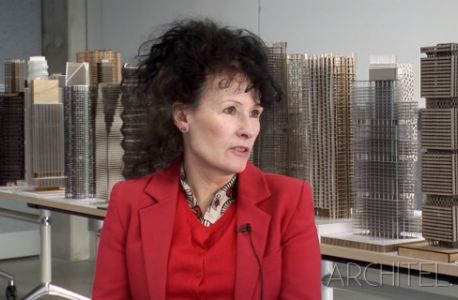Melbourne School of Design: Dr Karen Burns
This is part of a series of interviews and pieces co-produced by the Australian Design Review and the Melbourne School of Design (MSD). Here we speak to Dr Karen Burns, senior lecturer in Architectural Design at MSD. She is a frequent contributor to academic and professional architectural journals, a critic, and public commentator on issues in contemporary architecture. She is also the co-editor of Parlour, a website building discussion and exchange on women, equity and architecture.
What is your background?
I have two degrees in art history, and then I went to study architecture at RMIT. I had always been interested in architecture, and then I decided to become a researcher and scholar. I’ve worked at Monash and RMIT, among other places, before I started work at Melbourne Uni.
You are the Senior Lecturer in Architectural Design at Melbourne School of Design. What does your course cover?
I teach in the studio program, but I also teach a subject that looks at history and theory from 1965 to 2000. It’s a fantastic course to teach because we focus on a major era of upheaval and transformation in architecture and culture. The course takes us from critiques of modernism to the emergence of counterculture to debates around sustainability to the social role of architects. It’s a really important course in architectural thinking.

What makes MSD a better option than other schools offering architectural studies?
Our global studios. We have a travelling studio in landscape and urban design as well as in architecture. So the students go overseas and work – from the Galapagos Islands to places in South America. We’ve just had one student group come back from the Netherlands. Students who go overseas have worked on projects like looking at informal urbanism, and how people experiencing poverty are able to use their built environments as a resource. The students who have returned from the Netherlands looked at the issue of housing. All the projects vary. It’s a real opportunity for students to experience what it’s like to work in another culture, another society, and have to produce a design in that context. It’s about the experience of difference.
That really sets MSD apart, and so does its diversity. MSD doesn’t have a signature school style or ideological position. I think its intellectual and design diversity is also part of its commitment to interdisciplinarity. The university’s new headline about cultural collision is embedded in our approach to teaching and learning because we are looking at all sorts of possible intersections that generate design and ideas about the built environment.
What opportunities will students have once they have graduated from your course?
They can go and work in architectural offices, but the range of areas that graduates work in is very broad – they may work on building design, urban design, urban research, or they may work at the intersection of architecture and health. Lots of areas require very specialised knowledge now, so the architecture of healthcare is a real area of expertise. Education design is also a really important specialised field. These specialised areas are led by our scholars and research groups at MSD, and flow through to our teaching. Careers are also open to journalism on the built environment, and curatorial and museum work around design. In North America, it’s quite common for people to graduate from architecture courses and work on film set design. There are diverse paths.
What is the most exciting thing about working in the world of architecture?
The capacity to transform people’s lives and create change.
What would you say is the most important skill that young architects need to have?
Communication. They have to be able to talk clearly to their clients, their collaborators and everyone else.
You are the co-editor of Parlour – a site that discusses women in architecture. What are some of the specific challenges for women in the field?
Negotiating unconscious gender bias. Also the difficulties of maintaining a career in architecture if they have children and take on caregiving responsibilities. There are still people in the industry who don’t believe you can work flexibly, or work out of the office, or part-time. However, we have plenty of research that shows that companies and female and male caregivers – because men are also parents – who manage it all. Increasingly, the discontent around this issue is coming from young men as well as young women, because men aren’t necessarily interested in taking on the breadwinner ideal where they work 60 hours a week and barely see their children. There are a lot of examples of firms that have managed this very successfully. The Victorian Chapter of the Institute of Architects ran a fantastic seminar last year on practices that work flexibly, and a number of people from big practices and medium practices discussed how they managed it in their offices and what the benefits were in terms of having much better productivity, much happier employees and low turnover rates. So there is evidence for this.
What is your one piece of advice to those thinking of studying architecture?
Learn your strengths, weaknesses and interests. Then plot your course of your study and career based on a really strong sense of what you know about yourself and what you want out of life.
Learn more about Parlour.